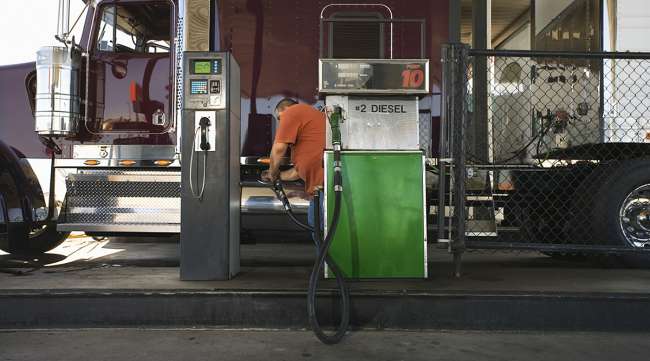Senior Reporter
Diesel Sees Slight Price Increase as Analysts Study Impact of Saudi Damage

[Stay on top of transportation news: Get TTNews in your inbox.]
While industry analysts continued to assess the damage to Saudi Arabia’s oil field from a Sept. 14 aerial attack, the nationwide price of diesel climbed by 1.6 cents to $2.987 per gallon, according to a weekly report from the U.S. Department of Energy issued Sept. 16.
A gallon of trucking’s main fuel cost $2.971 the previous week.
U.S. average #diesel fuel price on 9/16/2019 was $2.987/gal, UP 1.6¢/gallon from 9/09/19, DOWN 28.1¢/gallon from year ago https://t.co/dKWxdiLvdh #truckers #shippers #fuelprices pic.twitter.com/qGvG5HwWfs
— EIA (@EIAgov) September 17, 2019
An official with DOE’s Energy Information Administration told Transport Topics it could take up to two weeks for the price of crude oil, gasoline, diesel and other fuels to feel the full impact of the damage to the Saudi kingdom’s oil facilities. However DOE said the Sept. 16 report took into account that day’s market activity.
The price of West Texas Intermediate oil, the industry benchmark, rose by almost $7 a barrel Sept. 16, the first trading day after the attack. However, the price of WTI fell later in the week. On Sept. 18 it had dropped to $58.12.
This is the first increase in the price of diesel in 10 weeks, but diesel still costs 28.1 cents less than it did a year ago, when it was $3.268 a gallon. Every region of the country with the exception of New England saw the price of diesel increase. In New England, it fell by nine-tenths of a penny to $3.013 from $3.022 the previous week.
Prices increased the most in the Western states, rising 3 cents on the West Coast, not including California, which saw an increase of 2.3 cents per gallon for diesel.
Oil Industry Analyst Phil Flynn with Price Futures Group in Chicago believes diesel prices are poised to increase. The unstable Middle East is one factor, but so is the International Maritime Organization Jan. 1, 2020, mandate that cargo and cruise ships on the open seas significantly reduce their sulfur emissions. To comply, many shipping companies plan to switch to low-sulfur diesel from so-called bunker fuel that is now common. As a result, the shipping industry may soon claim a larger share of the nation’s diesel fuel, which could put pressure on prices, Flynn said.
“I think we can very easily put on another 50 cents from where we are now, maybe more,” said Flynn. “I’m not worried about shortages, but I think definitely you’re going to see higher prices.”
American Trucking Associations Energy and Environmental Counsel Glen Kedzie told Transport Topics he’s not in a panic mode over the possibility of higher prices, providing tensions in the Middle East drop.
“Maybe this is a one-and-done situation. There are many moving parts,” Kedzie said. “If Saudi Arabia gets its refining operations up and running sooner than anticipated that disrupter disappears.”
Saudi Arabia said Sept. 16 that it believes Iranian weapons were used in the attacks. The damage was the most sustained by the Saudis in 4½ years of civil war in neighboring Yemen, a conflict in which Saudi Arabia and Iran have key roles.
On Sept. 18 Secretary of State Mike Pompeo characterized the attacks on the Saudi oil industry as an “act of war,” and President Donald Trump ordered a substantial increase in sanctions against the government in Tehran. Meanwhile, Iran warned the United States that it would retaliate for any attack against it, according to Iranian news agency reports.
Oil Industry Analyst Tom Kloza with the Oil Price Information Service said the uncertainty over prices is impacted by how long it will take the Saudis to repair its facilities and if the saber rattling among Saudi Arabia, Iran and the U.S. intensifies.
I think it is a big deal, and I think it’s a change in the collective psyche of people who trade oil.
Oil Industry Analyst Tom Kloza with the Oil Price Information Service, on the impact of the attack on Saudi Arabia's oil field
“I think it is a big deal, and I think it’s a change in the collective psyche of people who trade oil,” Kloza said. However, he and other industry analysts cautioned against panic since the U.S. domestic oil situation has vastly improved over the past 10 years, with development of hundreds of new wells in West Texas, New Mexico, Oklahoma, North Dakota, Wyoming and Colorado.
The increased domestic oil production means gasoline and diesel prices are about $1 a gallon cheaper than they were in the spring of 2011, when according to EIA, diesel climbed to more than $4.10 a gallon nationwide and gasoline was $3.90.
In fact, EIA said the U.S. now produces more oil than Saudi Arabia. On Sept. 6, domestic U.S. production hit a record 12.4 million barrels.
WANT MORE NEWS? Listen to today's Daily Briefing
The attack cut Saudi crude production about in half, removing an estimated 5.7 million barrels per day of supply from markets, or 5% of global supply. Post-attack, Saudi Arabia was producing 9.8 million barrels of oil a day.
U.S. average price for regular-grade #gasoline on 9/16/2019 was $2.552/gal, UP 0.2¢/gallon from 9/09/19, DOWN 28.9¢/gallon from year ago https://t.co/nHE3AfiWDY #gasprices pic.twitter.com/l0FERmUwOL — EIA (@EIAgov) September 17, 2019
While the damage was extensive, Saudi Arabia said Sept. 17 it planned to restore most of its oil output to normal within weeks. For the short term it is using reserves to supply customers at pre-attack levels.
Meanwhile, the average price of a gallon of gasoline in the U.S. edged up by two-tenths of a cent to $2.552. By region, the price of gas nudged upward in just two regions and fell in six regions.





